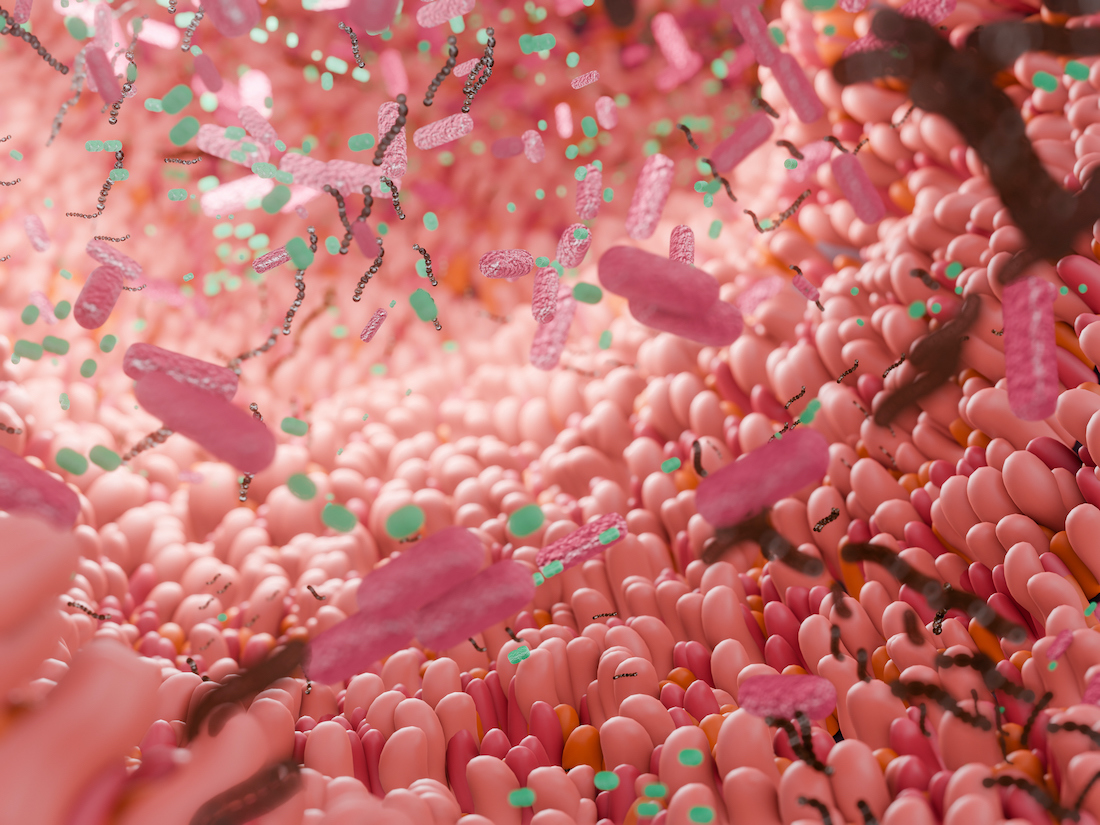Intestinal bacteria release molecular ‘brake’ on weight gain
UT Southwestern study in mice identifies host molecule, regulated by gut microbes, that inhibits absorption of dietary fats

(Photo credit: Getty Images)
DALLAS – Aug. 31, 2023 – Bacteria that live in the intestines inhibit a molecule that limits the amount of fat absorbed, increasing weight gain in mice fed a high-sugar, high-fat diet, researchers from UT Southwestern Medical Center report. The findings, published in Science, could eventually lead to new ways to combat obesity, diabetes, and malnutrition – health problems that plague hundreds of millions worldwide.

“We know that there are big differences in the composition of the gut microbiome between lean and obese mice, as well as lean and obese people. The question we’ve been grappling with is, does our microbiome cause metabolic changes that promote obesity, and if so, what are the molecular causes? This study paints part of that picture,” said Lora Hooper, Ph.D., Professor and Chair of Immunology, Professor of Microbiology, a member of the Center for the Genetics of Host Defense at UT Southwestern, and a Howard Hughes Medical Institute Investigator. Dr. Hooper co-led the study with Yuhao Wang, Ph.D., a former UTSW graduate student and postdoctoral researcher in the Hooper lab who is now a faculty member at Zhejiang University in Hangzhou, China.
Researchers have long known that “germ-free” mice, which have no gut microbiome and are maintained in sterile colonies, tend to be leaner than mice with gut microbes, especially when fed a Western-style high-sugar, high-fat diet. Searching for reasons why, Drs. Hooper and Wang and their colleagues used RNA sequencing to compare gene expression in the small intestines of germ-free mice and “conventional” counterparts with typical gut bacteria.
The team homed in on a gene called Snhg9, which produces a long, noncoding RNA whose function was unknown. A series of experiments showed that the RNA molecule produced by Snhg9 binds to a protein called CCAR2, setting off a molecular cascade that prevents dietary fats from being absorbed by the cells that line the intestine. Additional investigation showed that the intestinal cells that produced this RNA decreased its synthesis when they were alerted to the presence of gut microbes through a feedback loop governed by the immune system.
In germ-free mice and mice genetically altered to produce extra Snhg9 RNA, the process kicked off by this molecule protected them from becoming obese, even on a Western-style diet. Additional tests showed these animals weren’t absorbing as much dietary fat as wild type mice. However, mice genetically altered to lack Snhg9 gained excess weight on the high-sugar, high-fat diet, even when their gut microbes were killed off with antibiotics.
Together, the findings – which follow a 2017 paper led by Drs. Hooper and Wang that identified a molecular “accelerator” for lipid absorption and metabolism – help solve the mystery of how the microbiome regulates metabolism in host organisms. The discovery could eventually lead to ways to manipulate this interaction to prevent or treat metabolic diseases. For example, Dr. Hooper said, researchers may eventually be able to treat malnutrition by inhibiting Snhg9 or treat obesity by mimicking Snhg9 function with pharmaceuticals.
Dr. Hooper, a member of the Harold C. Simmons Comprehensive Cancer Center at UT Southwestern, holds the Jonathan W. Uhr, M.D. Distinguished Chair in Immunology and is a Nancy Cain and Jeffrey A. Marcus Scholar in Medical Research, in Honor of Dr. Bill S. Vowell.
Other UTSW researchers who contributed to this study were Yun Li, Ph.D., and Chaitanya Dende, Ph.D., Instructors of Immunology; Prithvi Raj, Ph.D., Assistant Professor of Immunology; Gabriella Quinn, B.S., and Tarun Srinivasan, B.S., graduate students; Brian Hassell, B.S., Research Assistant; and Kelly Ruhn, B.S., and Cassie L. Behrendt, B.S., Research Technicians.
This study was funded by the Ministry of Science and Technology of China (2021YFA0805600), the National Natural Science Foundation of China (32271213 and 82188102), the Leading Innovative and Entrepreneur Team Introduction Program of Zhejiang (2020R01006), the Fundamental Research Funds for the Central Universities (226-2023-00134), the National Institutes of Health (R01 DK070855 and R00 DK120897), The Welch Foundation (I-1874), the Walter M. and Helen D. Bader Center for Research on Arthritis and Autoimmune Diseases, and the Howard Hughes Medical Institute.
About UT Southwestern Medical Center
UT Southwestern, one of the nation’s premier academic medical centers, integrates pioneering biomedical research with exceptional clinical care and education. The institution’s faculty has received six Nobel Prizes, and includes 26 members of the National Academy of Sciences, 19 members of the National Academy of Medicine, and 14 Howard Hughes Medical Institute Investigators. The full-time faculty of more than 2,900 is responsible for groundbreaking medical advances and is committed to translating science-driven research quickly to new clinical treatments. UT Southwestern physicians provide care in more than 80 specialties to more than 100,000 hospitalized patients, more than 360,000 emergency room cases, and oversee nearly 4 million outpatient visits a year.
